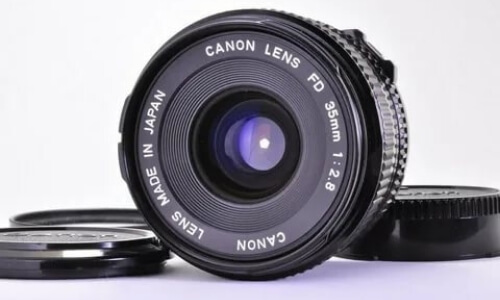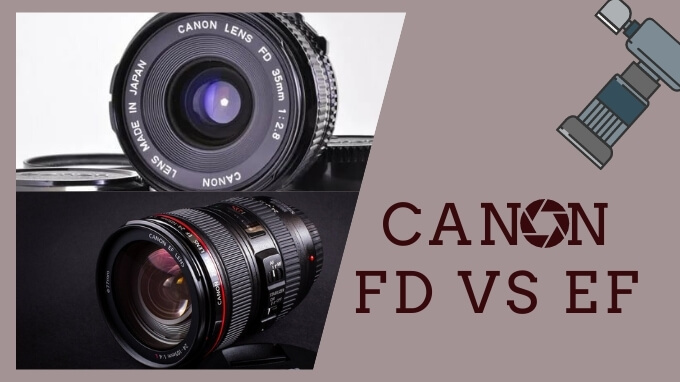Are you a photographer or a filmmaker? Are you looking to buy lenses for your SLR cameras? If yes, you might be hearing about different lenses, such as Canon FD or EF lenses available in the market. So, before buying, you must first know the specifications of the lens, what is the difference between them, and which one is better. In the following article, we will be explaining both the lenses and then comparing canon FD vs EF.
Canon FD Lens

The Canon FD lens developed by Canon Company of Japan mount is a physical standard used to connect a photographic lens to a single-lens reflex camera body. Introduced in March 1971, along with the Canon F-1 camera, it was used as an interchangeable lens mounting system for Canon SLR cameras. Its use was discontinued after the launch of the Canon EOS series with a newer EF lens mount.
Canon EF Lens

The EF lens mounts introduced in 1987 is a standard lens mount for the Canon EOS family of SLR and digital cameras. The full form of EF is Electro-Focus. An electric motor is built inside the lens to handle the automatic focusing of EF lenses. Mechanically, it is a bayonet-style mount, but there are no mechanical levers or plungers inside the EF lenses; all communication or control of focus and aperture between camera and lens occurs through electrical contacts.
As we know, the EF lens mount replaced the FD lens mount in 1987, but do you know what innovations were made in the EF mount? Let us study the features or characteristics that show how the EF lens mount is different from the FD lens mount.
Canon FD vs EF

Comparing different features of both the lenses, let us discuss the difference between the Canon FD lens and the EF lens.
1. Mechanism
The FD series of cameras use a standard manual focus lens mounting technology, wherein a motor along with a transfer lever was used in the camera body to drive the mechanics of the focus helicoid in the lens. However, in the EF series, a motor was used without any lever inside the lens itself for autofocusing. In the EF lens mount, the electrical contacts supply the power and instructions to the lens motor.
2. Bayonet placement
In the case of FD lens mount, three – eared bayonet is fitted on the camera body, and a breech-lock holder is provided to register and fasten the lens to the bayonet whereas, in EF series, the EF lens mount reversed the mechanical logic. It gives the bayonet on each lens and breech-lock holder on the camera body.
3. Clamping action of the bayonet holder
In the FD lens mount, two hands are required to attach the FD lens to the camera. One hand is needed to hold the lens in position, and the second hand to twist the breech-lock ring to lock the lens to the camera.
In the EF lens mount, only one hand is required, as the EF mount provides leaf springs in the holder, which holds the registration surface of the lens and the holder together along the optical axis. On manual twisting, the spring-loaded registration pin in the holder drops into a recess provided on a bayonet fitting, thus locking the lens to the camera. Hence the one-handed operation of the EF lens mount helps to change the lens in handheld photography.
4. Build Quality
The build quality between both the FD and EF lens is quite evident. Though EF lenses are larger, it is lightweight and plasticky compared to a heavy and compact FD lens.
The FD lens has a better focus ring with smooth pulls and hard stops, whereas the EF lenses are cheaper, and the focus ring is uneven with no hard stops.
5. Adaptability
Another point of comparison is adaptability. As FD uses manual focus mount technology, it requires a simple passive adapter, which is not expensive. The EF lens is electro-focus; hence it requires a more expensive active adapter that allows the camera to adjust it.
6. Sharpness
Now, comparing the lenses’ sharpness, both lenses are not sharp at the widest open aperture. But Canon EF seems to perform better than FD at F1.4. Later on, both perform significantly better as you increase the aperture diameter.
The main difference we can see is between the images rendered by these lenses. To add consistent contrast and color balance, an extra multilayer coating was added to the front lens of FD, which provides a uniquely classic look that many filmmakers go mad over.
Conclusion
From the above article, we hope that you have understood very clearly the difference between both the Canon FD and EF lens. FD is an old manual focus lens mount not suitable for autofocus and hence is not in use nowadays as compared to Electro-focus (EF) lenses. Overall looking at the mechanism and working point of view EF lens appears better than the FD lens. But in the case of adaptability and build quality, FD lenses are cheaper, compact, and heavy. Don’t worry if you have bought the FD lenses or already have it; they can still be used on EOS EF cameras using appropriate adapters. So go and enjoy your photography.

